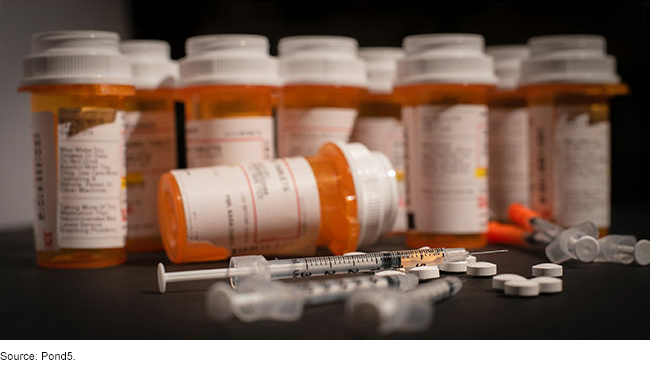Drug Manufacturing: FDA Should Fully Assess Its Efforts to Encourage Innovation
Fast Facts
The Food and Drug Administration has promoted advanced manufacturing—i.e., innovative technologies—as a way to address drug shortages. For example, it approved 2 drugs made using advanced manufacturing to treat a COVID-19 complication.
But we found that few drugs are manufactured using this technology, and the FDA doesn't know if all of its efforts to increase the technology's use are working. The agency hasn't formalized performance goals that define what it expects these efforts to achieve, or how it will assess progress toward these goals.
We recommended that the FDA address these issues.

Highlights
What GAO Found
The COVID-19 pandemic revealed vulnerabilities in the medical supply chain that led to drug shortages. The Food and Drug Administration (FDA) has highlighted advanced manufacturing—innovative technologies that improve product quality and process performance—as a way to enhance supply chain resiliency. However, at the time of this report, few drugs had been made using advanced manufacturing (see figure).
3D printing of drugs, an example of advanced manufacturing

FDA has three efforts focused on increasing advanced manufacturing for drugs related to (1) industry engagement, (2) policy and guidance, and (3) research. During the COVID-19 pandemic, FDA leveraged its industry engagement effort to approve two drugs for the treatment of a COVID-19 complication, which are made using advanced manufacturing technology. GAO found, however, that FDA lacks information on the extent to which its industry engagement and policy and guidance efforts encourage adoption of advanced manufacturing. This is because FDA has not documented and finalized performance goals—defining what it expects these efforts to achieve and performance measures—to regularly assess progress the agency is making in achieving these goals. Taking these steps would help FDA make informed program management decisions, including the allocation of finite resources.
The 15 industry stakeholders GAO interviewed reported that regulatory challenges contributed to uncertainty about when and whether a drug manufactured using advanced manufacturing will be approved. This uncertainty weakens the business case for, and contributes to slow adoption of, advanced manufacturing. For example, according to stakeholders, the unfamiliarly of FDA application review staff with advanced manufacturing may lead to delays in approval. FDA has taken steps to address regulatory challenges, including using its industry engagement program to provide opportunities for companies to discuss new technologies with FDA and its research program to familiarize staff with advanced technologies, such as through a yearly training on 3D printing.
Why GAO Did This Study
FDA, a component agency within the Department of Health and Human Services' (HHS), is responsible for ensuring that drugs marketed in the U.S. are safe and effective. The agency also plays a role in supporting manufacturing innovation. GAO has previously reported on challenges FDA has faced in its oversight of the drug supply chain and deficiencies in FDA and other HHS entities' preparation for and response to public health emergencies. As such, GAO has designated both as high-risk areas.
The CARES Act includes a provision for GAO to report on the federal pandemic response. This report (1) examines FDA's efforts to support advanced manufacturing, including in response to the COVID-19 pandemic. In addition, it (2) describes stakeholders' perspectives on the regulatory challenges to increasing the use of advanced manufacturing for drugs and (3) describes FDA actions to address challenges to increasing the use of advanced manufacturing. For this work, GAO reviewed FDA documents, national supply chain resiliency strategies, and interviewed FDA and 15 drug industry stakeholders, including companies with approved drugs and those seeking approval.
Recommendations
GAO is recommending that FDA document and finalize performance goals and measures related to its advanced manufacturing program efforts and regularly assess program progress. HHS concurred with this recommendation.
Recommendations for Executive Action
| Agency Affected | Recommendation | Status Sort descending |
|---|---|---|
| Food and Drug Administration | The Commissioner of FDA should ensure that, for its ETP and FRAME program efforts, CDER documents and finalizes (1) performance goals with specific targets and time frames, and (2) associated clear performance measures with measurable results, both of which are linked to its long-term strategic objectives. CDER also should regularly assess progress toward achieving program goals. (Recommendation 1) |
Open
HHS concurred with this recommendation. In an August 2023 response, FDA reported that CDER was developing a summary of performance indicators for ETP, including both performance measures and performance goals, that, once finalized, will be used internally to monitor progress toward achieving program goals. The response further noted that CDER continues to internally track progress for the FRAME initiative and plans to publish a public action plan which, we reported in March 2023, will include performance goals with specific targets and time frames, according to FDA officials. To close this recommendation, FDA needs to finalize its performance goals and measures for ETP and FRAME and provide documentation of such indicators and of CDER's regular assessment of progress toward achieving goals using such indicators.
|
